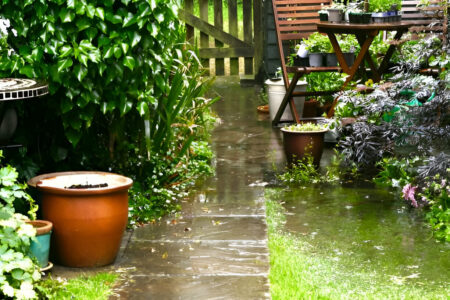Garden drains might not be the most glamorous part of gardening, but they are absolutely crucial. Whether you’re dealing with a soggy lawn, waterlogged flower beds, or simply want to prevent future issues, a good garden drainage system is your best friend. In this article, we’ll dive deep into the world of garden drains, helping you understand, plan, and maintain a system that keeps your garden in top shape.
Understanding Garden Drains
What are Garden Drains?
Garden drains are systems designed to manage excess water in your garden. They channel water away from areas where it might cause damage or create unfavorable conditions for plants.
Purpose and Benefits
The primary purpose of garden drains is to prevent water accumulation that can lead to soil erosion, root rot, and other gardening woes. Benefits include healthier plants, less maintenance, and a more enjoyable outdoor space.
Types of Garden Drains
French Drains
These are trenches filled with gravel or rock that direct surface water away from specific areas. They are effective and relatively easy to install.
Trench Drains
Similar to French drains but usually covered with a grate, trench drains are ideal for heavy rainfall areas as they can handle large volumes of water.
Channel Drains
These are surface drains designed to remove water quickly from driveways, patios, and other hard surfaces.
Dry Wells
A dry well collects and disperses water underground, preventing surface pooling. It’s an excellent solution for low-lying areas.
Sump Pumps
Sump pumps are used in areas prone to flooding. They pump water out of a sump basin to keep your garden dry.
Choosing the Right Garden Drain
Assessing Your Garden’s Needs
Start by examining your garden. Note areas where water collects and consider the severity of the drainage problem.
Climate Considerations
Your local climate affects the type of drainage system you need. Heavy rainfall areas will require more robust solutions.
Soil Type and Drainage
Different soil types (sandy, clay, loamy) drain water at different rates. This affects your choice of drainage system.
Planning Your Garden Drain System
Surveying Your Garden
Walk around your garden after a rainstorm to see where water accumulates. Use this information to plan your drainage system.
Identifying Water Flow Patterns
Observe the natural flow of water in your garden. This helps in designing a system that works with nature, not against it.
Designing a Drainage Plan
Draft a detailed plan showing the location and type of drains needed. Include measurements and materials required.
Installing Garden Drains
Tools and Materials Needed
Common tools include a shovel, gravel, perforated pipes, and geotextile fabric. Ensure you have everything before starting.
Step-by-Step Installation Guide
- Dig Trenches: Follow your plan and dig trenches where drains will go.
- Lay Pipes: Place perforated pipes in the trenches, ensuring proper slope.
- Add Gravel: Cover pipes with gravel to improve drainage.
- Cover with Fabric: Use geotextile fabric to prevent soil from clogging the system.
- Fill Trenches: Backfill trenches with soil and level the surface.
Common Mistakes to Avoid
Avoid placing drains too shallow, not providing enough slope, and forgetting to cover pipes with fabric.
Maintaining Your Garden Drains
Regular Inspection Tips
Check your drains regularly, especially after heavy rain. Look for signs of clogging or damage.
Cleaning and Unclogging
Remove debris from grates and pipes. Use a garden hose to flush out any blockages.
Seasonal Maintenance
Prepare your drainage system for each season. For example, clear out leaves in the fall to prevent clogs.
Common Problems and Solutions
Identifying Drainage Issues
Common issues include water pooling, slow drainage, and soil erosion. Identify these early to prevent bigger problems.
Troubleshooting and Repairs
If a drain isn’t working, check for blockages or damage. Simple fixes often involve clearing debris or replacing damaged sections.
Preventive Measures
Prevent issues by regular maintenance and addressing small problems before they escalate.
Enhancing Garden Aesthetics with Drains
Blending Drains with Landscape
Incorporate drains into your garden design. Use gravel paths or decorative rocks to hide drains.
Decorative Drain Covers
Choose covers that match your garden style. Options range from rustic to modern designs.
Using Plants to Assist Drainage
Plants like grasses and shrubs can help absorb excess water, reducing the burden on your drainage system.
Eco-Friendly Drainage Solutions
Sustainable Practices
Use recycled materials for your drains. Consider water conservation methods like rain barrels.
Rain Gardens
These gardens are designed to absorb rainwater, reducing runoff and improving water quality.
Permeable Paving
Permeable paving allows water to seep through, reducing runoff and replenishing groundwater.
Cost Considerations
Budgeting for Installation
Plan your budget carefully. Costs can vary depending on the type and extent of the drainage system needed.
Long-Term Savings
Investing in a good drainage system can save money in the long run by preventing damage and reducing maintenance.
Cost-Effective Materials
Use affordable yet durable materials to keep costs down without compromising quality.
DIY vs. Professional Installation
Pros and Cons of DIY
DIY can save money but requires time and effort. Consider your skills and the complexity of the project.
When to Hire a Professional
For large or complex projects, hiring a professional ensures the job is done correctly and efficiently.
Finding a Reliable Contractor
Look for contractors with good reviews and experience in garden drainage systems.
Real-Life Case Studies
Successful Garden Drainage Projects
Learn from others who have successfully managed their garden drainage. Case studies provide practical insights and tips.
Lessons Learned
Understand the challenges and solutions from real-life projects to avoid common pitfalls.
Tips from Homeowners
Get advice from homeowners who have installed and maintained their own garden drains.
Future Trends in Garden Drainage
Technological Advances
New technologies are making garden drainage more efficient and easier to manage.
Smart Drainage Systems
Smart systems can monitor water levels and manage drainage automatically.
Innovations to Watch For
Stay updated on the latest innovations in garden drainage to keep your garden at its best.
Conclusion!!
A well-planned and maintained garden drainage system is essential for a healthy, beautiful garden. By understanding your garden’s needs, choosing the right type of drains, and committing to regular maintenance, you can prevent water-related issues and enjoy a thriving outdoor space. Don’t wait for the next heavy rain to take action—start planning your garden drainage system today.







